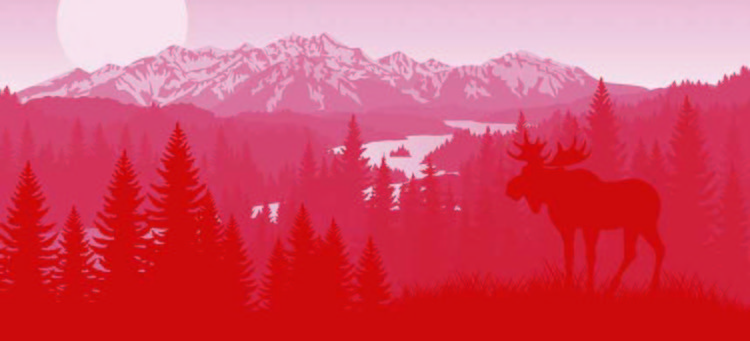
Conversations
150 years of Canadian trivia: True North Facts for Thee
By Robert Michon with Jennie Drent
June, 2017
If you hadn’t heard, this year is Canada’s 150th anniversary. And while many people are drawing attention to the huge nation-building events that have defined our country, there is something to be said for the smaller cultural phenomenon that tend to escape the notice of most people. In honour of Canada’s sesquicentennial celebration, we’ve gathered a few facts that celebrate the more obscure side of Canada’s history and culture, facts that you’re sure to be able to impress your friends with during the celebrations.
Canadian Origins
Canada’s official motto is “A Mari usque ad Mare” which is Latin for “From Sea to Sea.” The phrase was taken from Psalm 72:8 during the Confederation as an inspirational statement, even though Canada, at that time, had only one coastline—the Atlantic. It wasn’t until British Columbia joined in 1871 that the statement rang true. Today, at the suggestion of the three territories, Canadians are using “From Sea to Sea to Sea” to include the Arctic coast, though it’s not official.
Though Canada is celebrating its 150th birthday this year, Canada’s Indigenous peoples have been living on this land for much longer than that. During the 1980s, archeologists uncovered a collection of bones and tools in Yukon’s Bluefish Caves. These artifacts are estimated to be between 24,000 and 28,000 years old, meaning that Canada’s first wave of settlement occurred long before recorded history.
Geography
The creation of Alberta and Saskatchewan wasn’t the only option the Canadian government was considering when dividing up the prairies. One plan called for the creation of one large prairie province called “Buffalo” with Regina as its capital. Another plan called for four prairie provinces: Alberta, Saskatchewan, Athabasca and Assiniboia.
Since Canada enjoys peaceful relations with most nations in the world, one of our longest-standing border disputes might come as a surprise. Since 1980, Canada and Denmark have been involved in a disagreement over which nation owns Hans Island, a small, uninhabited, resource-barren, one-kilometre stretch of rock that can be found about halfway between Baffin Island and Greenland. Though discussions have been civil, neither country has been willing to give up its claim on the island.
Just 25 kilometres off the southwest coast of Newfoundland are two small islands that belong to France: Saint Pierre and Miquelon. They have 6,500 inhabitants, cod fishing is their main industry (though tourism is gaining momentum) and they have zero atmospheric pollution. They claim to have the climate of the Shetland Islands, the architecture of Iceland, the landscape of Scotland and the culture of France.
Innovation
Our prairie provinces have always been known for their top-quality wheat, but with our long winters and short summers, it wasn’t always easy to grow. In 1892, brothers Percy and Charles Saunders were able to cross Red Fife wheat with a variety from India called Hard Red Calcutta, which led to a quick-growing, high-quality wheat called “Marquis” that we still grow today.
In 1857, a professor at McGill University invented the green ink used on American greenback money. Thomas S. Hunt was a chemist with the Canadian Geological Survey, and he suggested that the American banknote contain chromium trioxide (Cr2O3). It’s this chemical that makes counterfeiting American money tricky.
Our country has always been proud of inventions like basketball and the zipper, but Canada was also a pioneer in the field of digital animation. In 1994, Vancouver’s Mainframe Studios released the first computer-animated television show ever: a science fiction cartoon called Reboot. Disney’s Toy Story, the first digitally animated film, wasn’t released until a year later in 1995.
Language
Canada is a bilingual country, but only one province is officially bilingual: New Brunswick. The Official Languages Act doesn’t apply to provincial and municipal governments, but New Brunswick decided to officially adopt a bilingual policy out of respect to the mix of Anglophone and Francophone communities in the province. This means that if you want to converse in French at any government institution such as a hospital or a police station in New Brunswick, you have that right.
Aside from Canada’s two official languages, it’s also home to over 60 indigenous languages that aren’t spoken anywhere else in the world. Of these 60-plus languages, most are in danger of being lost. Stats Canada estimates that only Cree, Ojibwa and Inuktitut have enough speakers for the languages to survive without outside aid.
Most of us know that the name “Canada” comes from the Haudenosaunee (or Iroquois) word for “village.” But four of our provinces and two of our territories have names that can be traced back to Indigenous Canadian roots as well.
- Québec means “Where the river narrows” in Algonquin, and refers to the narrow spot along the St. Lawrence River where Québec City was built.
- Manitoba means “The Narrows of the Great Spirit” in Cree, describing the shape of Lake–Manitoba, as well as its cultural significance.
- Saskatchewan is named for the Saskatchewan river system that runs through the prairies and means “Swift-flowing River” in Cree.
- Nunavut means “Our Land” in Inuktitut and was chosen to be the official name of the territory when it was formed in 1999.
- The Yukon Territory is named for the Yukon River that flows through it, a name that means “Great River” in Gwich’in.
- Ontario is named for Lake Ontario, which means “Sparkling Waters” in the Haudenosaunee languages.
Natural Canada
Wood Buffalo National Park is home to the world’s largest beaver dam. Just how big is it? It’s 850 metres long and can be seen from space. No one knows how old it is, but it was only discovered in 2007 by a researcher looking at satellite images; research suggests it wasn’t around before 1975. If you’re wondering how anyone could miss such a large beaver dam, remember that Wood Buffalo has a larger area than Switzerland.
Canada has more natural lakes than all other countries in the world combined. In fact, half of the natural lakes found in the world are found within our borders. According to the Canadian Encyclopedia, there are over 2 million lakes that cover close to 8% of Canada’s 10-million-km2 surface area with fresh water. Another fact is the entire water volume in these lakes is large enough to flood this county to a depth of 2 metres.
If you want to lose weight without exercising or dieting, head to the Hudson Bay Region. The gravity there is less than most other places on Earth—one-tenth of an ounce to be exact. This lower gravity was discovered in the 60s, and the widely accepted hypothesis among scientists to explain it has to do with the last ice age and the Laurentian Ice Sheet. The ice sheet was over 3 kilometres thick, and it pushed down the rock quite far and reduced its mass. The rocks are still recovering from this pressure.
Canadian Arts
During the first few decades of the modern Olympic Games, not all the competitions revolved around feats of athletic prowess. Contestants were also able to compete in several artistic competitions including architecture, literature, music, painting and sculpture. Canada’s only Olympic medal in an art event was won by Torontonian musician John Weinzweig. Weinzweig came in first place but was awarded silver for his composition, as the judges didn’t feel that any of the pieces were worthy of a gold medal.
The first Canadian published stories were non-fiction accounts of travel and adventure written by European explorers like Sir Alexander Mackenzie. The first Canadian novel was written in 1769 by a British resident of Quebec named Frances Brooke. Brooke’s novel was called History of Emily Montague, and it tells the story of a blossoming romance in the heart of snowy Quebec. The first Canadian publisher surfaced 20 years later in 1789. The Nova Scotia Magazine, as it was known, published poetry and short stories in addition to news and editorials.
The term documentary was first coined by Scottish-Canadian filmmaker John Grierson. Grierson was the founder of the National Film Board, a government body that was created during the Second World War with the purpose of coordinating Canadian filmmakers in the production of wartime propaganda films. In Grierson’s mind, there was no better way of informing the public than a propaganda-rich documentary film. We’ve moved beyond the idea of propaganda being a tool for the public good, but we still have Grierson to thank for the birth of the Canadian film industry.
Northern Cuisine
An American may have invented the clam-infused tomato juice cocktail, but a Canadian perfected it and called it the “Caesar.” Walter Chell took months to perfect this Canadian cocktail to celebrate the Calgary Inn’s new restaurant, Marco’s Italian. Soon after the Caesar was created, Mott’s Beverage Company started to market their Clamato beverage, and now over 350 million Caesars are consumed in Canada each year.
You may know that there are more doughnut
shops per capita in Canada than anywhere else in the world (mainly due to the popularity of Tim Horton’s), but this also means we eat a lot more doughnuts than anyone else in the world. There are over 3,600 Tim Horton’s across Canada selling over 3 million doughnuts a day. And a doughnut just doesn’t taste the same without a cup of coffee. In 2016, Canadians drank 14 billion cups with
2 billion of those coming from Tim Horton’s.
Canadians love their beer. According to Beer Canada, Canadian adults drink around 63 litres per person every year. In total, that comes to about 22 million hectolitres drunk every year, 84% of which is Canadian brewed. And where there is beer, there are a lot of empty bottles. About 99% of beer bottles get returned for recycling in Canada.
Wartime
Immediately following the Second World War, the Royal Canadian Navy was the third largest navy in the world. While many of the world’s powers were losing the majority of their ships in military engagements, Canada’s naval support role meant that it was able to produce more ships than it was losing. In fact, Canada was the only nation to end the war with more ships than it started with.
The Nile Expedition was Canada’s first overseas participation in a war. It began in 1884 when an uprising occurred in British-controlled Sudan. When British and Egyptian forces were captured by the rebelling Sudanese, Canada’s Governor General Landsdowne recruited 376 voyageurs (mainly lumbermen) to help rescue them. These voyageurs were skilled river navigators and for six months, they guided the expedition’s boats up the Nile River to Khartoum. Two days before they reached Sudan’s capital city however, the captives were killed, and the voyageurs returned home.
During the Cold War, it was common for governments to construct nuclear fallout shelters that they could retreat into in the event of a nuclear crisis. Canada was no different. Under the leadership of Prime Minister John Diefenbaker, the government constructed the “Central Emergency Government Headquarters,” an underground bunker located in a field just west of Ottawa. This bunker could house 565 government officials for a period of one month, which they hoped would be long enough for the radiation to subside. Today the shelter is open to the public as a museum and is affectionately called “The Diefenbunker.” t8n
Did You Know?
The Government of Canada is slated to spend a total of half a billion dollars on Canada 150 celebrations. This money is divided among nationwide celebration events, merchandise, and infrastructure improvements. It’s a lot of money, but it doesn’t even include the amount being spent by provincial and municipal governments on their own celebrations.
Fun Fact
Though 150 years may not seem like a long time, wars, colonization, and political instability mean that most of the world’s current nations were formed in the last 100 years, making Canada one of the older countries on the planet.













